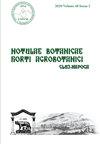近红外光谱和多变量方法鉴别不同生长阶段的牵牛花
IF 1.3
4区 生物学
Q3 PLANT SCIENCES
引用次数: 0
摘要
牵牛花是一种在热带作物中非常常见的杂草,它们对热带作物造成直接和间接的损害。对这些物种的管理主要依赖于除草剂的施用,而忽视了它们的生长阶段和空间分布。研究识别这些物种的新技术可能有助于近端传感器的发展,以进行具体和合理的管理。因此,本研究的目的是利用近红外光谱(NIRS)和多变量分析对两种牵牛花的三个生长阶段进行区分。在4.000 ~ 10.000 cm-1的光谱范围内,采集了山茱萸和埃及山茱萸3个不同阶段的近红外光谱。采用PCA和PC-LDA分析全光谱和特定波段。近红外光谱与PCA和PC-LDA相结合,可以有效地区分喜多叶和埃及伊蚊的种类和生长阶段。当单独应用PCA时,PC-LDA可以正确分类90.93 ~ 100%的物种和阶段。在4.500 ~ 6.000 cm-1和4.500 ~ 6.000 + 6.500 ~ 7.750 cm-1的近红外光谱范围内,分辨效果最好。这项研究代表了近红外光谱技术在研究和实施方面的一个进步,该技术可以区分杂草种类,为未来设备的开发提供帮助,以帮助采用和/或实施特定的杂草管理,从而有助于减少作物除草剂的使用。本文章由计算机程序翻译,如有差异,请以英文原文为准。
NIRS and multivariate methods for discrimination of morning glory species at different growth stages
Morning glory species are weeds very common in tropical crops, where they cause direct and indirect damage. The management of these species primarily relies on the application of herbicides, disregarding the growth stage and spatial distribution. Studies addressing new techniques for identifying these species may contribute to the development of proximal sensors for carrying out specific and rational management. Thus, the objective of this work was to use near infrared spectroscopy (NIRS) and multivariate analysis to discriminate two species of morning glory in three growth stages. NIRS spectra were collected from Ipomoea hederifolia and Merremia aegyptia were collected at three different stages in the spectral range of 4.000 to 10.000 cm-1. PCA and PC-LDA were used to analyze the entire spectrum and specific bands. NIRS associated with PCA and PC-LDA were sufficient to discriminate I. hederifolia and M. aegyptia species and their growth stages. PCA allowed a proper segregation of stages and species when applied individually PC-LDA correctly classified between 90.93 to 100% of species and stages. The best discrimination results were observed in the NIR spectra ranges from 4.500 to 6.000 cm-1 and 4.500 to 6.000 + 6.500 to 7.750 cm-1. This study represents an advance in the research and implementation of NIRS technology to discriminate weed species for the future development of equipment to assist in the adoption and/or performance of a specific management of weeds, capable of contributing to the reduction in the use of herbicides in crops.
求助全文
通过发布文献求助,成功后即可免费获取论文全文。
去求助
来源期刊

Notulae Botanicae Horti Agrobotanici Cluj-napoca
PLANT SCIENCES-
CiteScore
2.70
自引率
0.00%
发文量
118
审稿时长
3 months
期刊介绍:
Notulae Botanicae Horti Agrobotanici Cluj-Napoca is a peer-reviewed biannual journal aimed at disseminating significant research and original papers, critical reviews and short reviews. The subjects refer on plant biodiversity, genetics and plant breeding, development of new methodologies that can be of interest to a wide audience of plant scientists in all areas of plant biology, agriculture, horticulture and forestry. The journal encourages authors to frame their research questions and discuss their results in terms of the major questions of plant sciences, thereby maximizing the impact and value of their research, and thus in favor of spreading their studies outcome. The papers must be of potential interest to a significant number of scientists and, if specific to a local situation, must be relevant to a wide body of knowledge in life sciences. Articles should make a significant contribution to the advancement of knowledge or toward a better understanding of existing biological and agricultural concepts. An international Editorial Board advises the journal. The total content of the journal may be used for educational, non-profit purposes without regard to copyright. The distribution of the material is encouraged with the condition that the authors and the source (Notulae Botanicae Horti Agrobotanici Cluj-Napoca or JCR abbrev. title Not Bot Horti Agrobo) are mentioned.
 求助内容:
求助内容: 应助结果提醒方式:
应助结果提醒方式:


